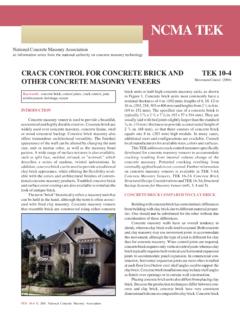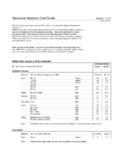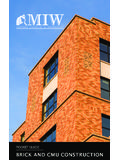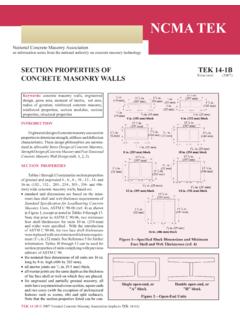Transcription of What’s changed? Equivalent Web Revisions C90 Equivalent ...
1 Architecture/Engineering/Construction Industry UpdateASTM C90-11b - Hollow Loadbearing concrete masonry UnitsIn late 2011 ASTM C90, the material specification for hollow loadbearing CMU, was modified to permit the cross-webs of units to be configured in different ways to meet specific project needs and performance require-ments. As this allowance works its way into local construction, here is a short review of how this new flexibility on unit configurations can benefit your next s changed ?Under new C90 requirements, web configurations are no longer regulated by their thickness, but rather the cross-sectional area of the web connecting the face shells of a , this new requirement means that for every square foot of unit surface, no less than (4193 mm2) of web must connect the front and back face shells, with no web measuring less than in.
2 (19 mm) in of acceptable web configurationsAllowing the option to reduce the cross-web thickness and/or area, allows for a greater array of unit configura-tions. Not every unit configuration is available in every market. Contact your local CMU manufacturer to explore the range of possibilities available. Cross-Section ViewsPotential impact of ASTM C90 changeIncreased R-ValuesReducing the cross-webs has the potential to sub-stantially increase the energy efficiency of con-crete masonry assemblies by reducing the thermal bridges that result from the cross-webs. R-values can increase 2 to 3 times above baseline; while retaining all the intrinsic benefits of thermal RatingsBecause the most common method of determining fire ratings is based on the Code-approved method of Equivalent thickness (the amount of concrete that remains if the unit was recast without voids), reducing the size and thickness of cross-webs reduces the Equivalent thickness of the unit, which for a given mix design will reduce the calculated fire resistance rating of the assembly.
3 Nevertheless, units can be produced to meet any fire resistance rating required by code and can always use the Equivalent thickness method to calculate the fire resistance rating. To assure wall performance, specific fire ratings for walls should be identified on drawings/wall sections and listed in project specifications. Sustainable AttributesUsing less material in production reduces: the demand on resources; the energy necessary to manufacture products; and the fuel required to transport units to job sites while maintaining the high durability, low impact solution inherent in concrete change does not reduce the structural performance for load bearing masonry .
4 Other unit properties such as face shell thickness and unit compressive strength remain unchanged. In addition, larger cell areas reduce the rein-forcement congestion and facilitates grout on Wall CostLighter weight units can increase construction pro-ductivity and reduce worker fatigue and injuries. This can lead to lower costs for con-crete masonry wall , Discussion, Future StrategiesC90 Equivalent Web Revisions16 Energy Efficiency The webs are thermal shorts : smaller webs = larger to envelope primary motivation behind this webs = Larger R-valuesImpact, Discussion, Future StrategiesEquivalent Web Revisions9 The minimum web cross-sectional area is square foot of wall out to web for an 8 x 16 in.
5 Unit with no web less than in. in unit is does this (literally/abstractly) mean?1 , Discussion, Future StrategiesEquivalent Web Revisions10 Alternatively, the three webs of a traditional unit can be made slightly thinner; but no less than well as does this (literally/abstractly) mean? , Discussion, Future StrategiesEquivalent Web Revisions11 Likewise, the heights of the web of the units can be reduced. Further, because the new web criteria is based on the wall surface area of the installed unit, these same criteria apply to units of different face dimensions ( , half-high units).
6 And does this (literally/abstractly) mean? , Discussion, Future StrategiesEquivalent Web Revisions11 Likewise, the heights of the web of the units can be reduced. Further, because the new web criteria is based on the wall surface area of the installed unit, these same criteria apply to units of different face dimensions ( , half-high units).And does this (literally/abstractly) mean? , Discussion, Future StrategiesEquivalent Web Revisions11 Likewise, the heights of the web of the units can be reduced. Further, because the new web criteria is based on the wall surface area of the installed unit, these same criteria apply to units of different face dimensions ( , half-high units).
7 And does this (literally/abstractly) mean? in. Efficiency Strategies for concrete masonry Construction: December 29, 2011 Page 1 Energy Efficiency Strategies for concrete masonry Construction December 29, 2011 Greetings All, As you may have heard by now, the change proposal that NCMA submitted earlier this year to modify the minimum web requirements within ASTM C90, Standard Specification for Loadbearing concrete masonry Units, was recently approved by ASTM. While it typically takes ASTM a few weeks to issue an updated standard (expect the next edition of ASTM C90 to be available in mid-January), the changes shown below reflect what was approved (including some editorial tweaking from the Committee).
8 TABLE 1 Minimum Thickness of Face Shells and Webs RequirementsANominal Width (W) of Units, in. (mm) Face Shell Thickness (tfs), min, in. (mm)B,CWebs Thickness (tw)Web ThicknessC (tw),WebsB,D,C min, in. (mm) Equivalent Web Thickness, min, ftE (mm/linear m) Web Area (Aw), min, (mm2/m2)D3 ( ) and 4 (102) (19) (19) 15/8 (136) 6 (152) 1 (25) 1 (25) 2 (188) 8 (203) 1 (32) 1 (25) 2 (188) 10 (254) and greater 1 (32) 11/8 (29) 2 (209) 3 ( ) and 4 (102) (19) (19) (45,140) 6 (152) 1 (25) (19) (45,140) 8 (203) and greater 1 (32) (19) (45,140) A Average of measurements on a minimum of 3 units when measured as described in Test Methods C140.
9 B When this standard is used for units having split surfaces, a maximum of 10 % of the split surface is permitted to have thickness less than those shown, but not less than 3 4 in. ( mm). When the units are to be solid grouted, the 10 % limit does not apply and Footnote C establishes a thickness requirement for the entire face shell. C When the units are to be solid grouted, minimum face shell and web thickness shall be not less than 5 8 in. (16 mm). D The minimum web thickness for units with webs closer than 1 in. ( mm) apart shall be 3 4 in. ( mm). DE Minimum web cross-sectional area Equivalent web thickness does not apply to the portion of the unit to be filled with grout.
10 The length of that portion shall be deducted from the overall length of the unit for the calculation of the minimum web cross-sectional area Equivalent web thickness. As we have discussed over the past year, this change while not requiring any changes to unit configuration(s) provides significantly more flexibility to allow units to be reconfigured to meet specific market needs. This could include reduced material use, reduced unit weight for transportation and installation, and possibly most significantly, increases in the energy efficiency of concrete masonry construction by reducing the thermal bridge across the webs of a unit.






